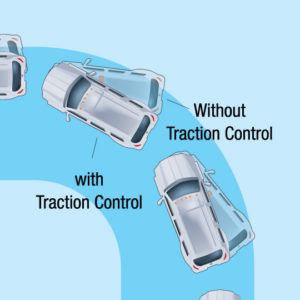- March 31, 2017
- By Bobbie Hicks
- In Uncategorized
- Tags ABS, anti lock brakes, auto repair, bucks county, doylestown, mechanic, traction control
- 4590
- 0
 Traction control works in conjunction with your anti-lock brake (ABS) system to help with vehicle control. It senses the wheel spin in each of your 4 tires and automatically reduces the throttle and/or applies the brakes at any of those individual tires to help maintain traction (and therefore, control.)
Traction control works in conjunction with your anti-lock brake (ABS) system to help with vehicle control. It senses the wheel spin in each of your 4 tires and automatically reduces the throttle and/or applies the brakes at any of those individual tires to help maintain traction (and therefore, control.)
Traction control is hardly a new technology, with early systems being installed in several models as early as the ‘90’s. If your car was manufactured within the past 12 or so years, you most likely have traction control in your car.
A more sophisticated variation of traction control, called electronic stability control (ESC) has been required in all vehicles produced starting in 2012. ESC helps with steering in addition to traction. By monitoring steering wheel angle for sudden jerks, it will help to prevent spin-outs or swerves by applying the brakes and reducing throttle. This is helpful, for example, when there is a sudden road hazard, such as an animal or tree branch.
Just like anything else on a car, these systems require maintenance and can sometimes fail for a number of reasons. When your traction control system is failing, you will get a specific light on your dashboard.
There are several reason why the light will go on:
Each wheel has a sensor that monitors speed and sends that information to the management system. The readings help to determine if power needs to be altered in each wheel at any given time. These sensors can get covered in dirt and are prone to wear and tear.
Since traction control systems are mainly electrical, wear and tear can also affect any of the various wires and connection with the system, which may need to be repaired or replaced.
As we stated earlier, the traction control system works in conjunction with your anti-lock brake system. Depending on the issue, the traction control light can go off along with the ABS light simultaneously.
Often times, your car might be low on break fluid. When this happens, your car can’t brake hard enough. You can often tell based on how your car responds when you brake; It may feel soft/spongy and/or simply not respond well enough. This is a potentially dangerous issue as your ability to brake is compromised.
Most cars are equipped with the ability to turn the traction control feature off. When it is off, the light will go on. When you turn your car on, check to make sure you’re your traction control is turned on.
Most typically, you can drive your car if the light is on but should make it a point to have it checked out since it an important safety feature on your car. You should use extreme caution, particularly when road conditions are bad since your system may not be on. Since the warning light can also mean ABS issues, you will also want to be very careful when stopping.
If your traction control light goes on, be sure to bring it in to BBack Car Care for a system diagnosis. Our team can pinpoint the issue and get it fixed in no time. The result is great peace of mind and safer driving.
Ready to book an appointment? Fill out the form online or call us today.